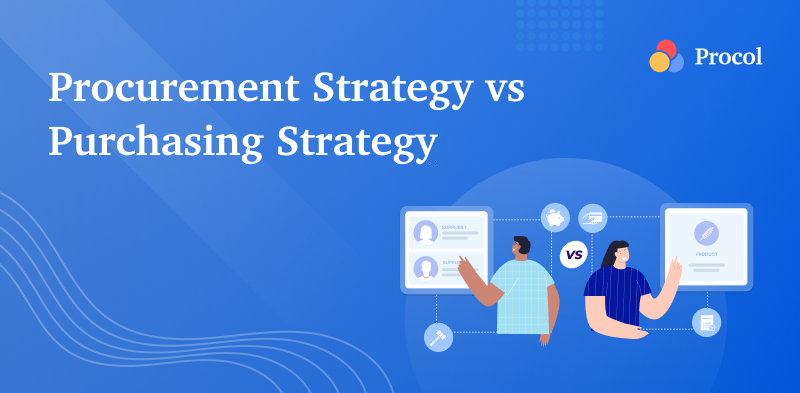How purchasing strategy and procurement strategy differs

TABLE OF CONTENTS
Sometimes the terms ‘procurement’ and ‘buying’ are used interchangeably. The major contrast between the terms is that purchasing is concerned with transactional chores, whereas procurement is concerned with strategy and the final product sourcing process. The sourcing and acquisition of products and services from a third-party vendor or supplier is the focus of procurement.
On the other hand, Purchasing defines how orders for various commodities and services are placed. To acquire the correct things, for example, you must first understand your organization’s budget. To comprehend the process of purchasing, obtaining products or services, and how procurement managers approach the payment process, you must first grasp the following:
-
Purchase approvals and spending requests
-
Production of a purchase order
-
Executing the purchase demand
Procurement Vs Purchasing Strategy
Purchasing
Purchasing is the act of buying different things for your business, focusing on the point of transaction. The act of purchasing is to answer the question: “What essentially does your business need and how much are you paying for it?” Strategic purchasing only accounts for selecting a product, its pricing, and the exchange of money, not the entire process of procuring for your business.
Steps in the purchasing strategy:
To put it simply, purchasing is a subset of procurement. Moreover, unlike procurement, purchase tasks are defined. You must expressly adjust the processes to the size and breadth of each vendor from whom you are ordering. This is a critical stage in developing an appropriate purchasing strategy.
Here is a summary of the complete procedure:
-
Accepting a purchase order - Sending a shipping notification (in advance) - Collecting products and submitting receipts
-
Performing an invoice recording - Performing a three-way match
-
Making payment to the seller
Procurement
Procurement is a strategic array of processes that includes both purchasing and sourcing different goods. Procurement is a set of protocols for selecting a vendor, and includes the optimisation of supplier relationships, risk management for businesses, supply chain management, market analysis, and more.
To pick one strategy over the other, your business needs to identify whether it needs to save money or build resilience using a procurement strategy.
It is important to have a procurement strategy since it impacts the profit margin directly. For example, the cost of procuring goods must be less than what they sell them for, minus the costs associated with selling/processing them.
Let’s look at some major differences between the two terms based on multiple criteria:
- The End Goal
Procurement and purchasing differ in their end goals. For instance, procurement aims at identifying the exact organisational needs and then implementing/fulfilling the procurement of those needs. However, purchasing is done to arrange the organisation’s budget and buy relevant goods/services for the organisation.
- How are goods and services assessed
While discussing procurement, it works on assessing the item’s value and not so much on the cost. It emphasises how valuable an item is rather than how expensive it is. On the other hand, when you’re talking about purchasing, the simple rule of price over value implies.
- Where is it beneficial?
Based on such elemental differences, it’s affirmative to say that the two areas – procurement and purchasing are beneficial in different areas. The former is involved in a more end-to-end activity-handling to acquire all the necessary goods and services. And the latter gets involved when it’s time to buy goods and services.
- The tasks involved
The tasks involved are another point of difference between the two areas. Procurement includes everything from recognition to sourcing, contract closure, and record keeping. At the same time, purchasing involves tasks such as ordering, expediting, and payment.
- How it deal with suppliers
When you talk about procurement, it deals with developing a long-term beneficial relationship with the suppliers. On the other hand the main part for purchasing on the efficient transaction, which is not entirely concerned with supplier-vendor relationships.
Overall, purchasing is a process that occurs within procurement and must not be understood otherwise. Therefore, it has become imperative for one to practice purchasing and procurement in the current business world.
How can we automate your procurement and purchasing strategy with E-procurement?
According to reports, more than 75% of CPOs believe that they will deliver a digital procurement strategy in the coming five years.
When it comes to a procurement strategy, it is a long-term plan to acquire and manage the necessary supplies cost-effectively. It involves an in-depth analysis of your business data, economic and financial data to result in better operations, spending forecast, revenue impact, and more. More typically, a procurement strategy would depend on several factors, including the purchase timeline, available budget, and the exact cost of ownership, along with knowing more about your potential risks and more.
Types of Procurement Strategies
Based on reports, digital tools can help sort and manage your strategies well enough. There are a few common procurement strategies or components of strategies that different businesses can adopt, such as:
-
Cost reduction
-
Risk management
-
Supplier management and optimisation
-
Global sourcing
-
Green purchasing
-
Quality management
Overall, cutting expenditures and finding better prices is the path to better business growth. Automation of your procurement strategies can help you cut down on your expenses and save you resources for other tasks. If you are looking for better business solutions, procurement tools, and an ideal procurement strategy, get in touch with our experts today.
Get a Free Demo
We'd love to hear from you. Please fill out this form to schedule a demo with us. You can also give a call on +91 76666 82222



